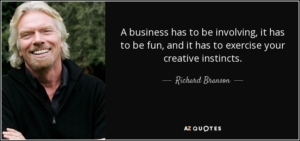What Is A Salesman?

What Is A Salesman
(Source Unknown)
A salesman is a pin on a map to the sales manager, a quota to the factory, an overloaded expense account to the auditor, a bookkeeping item called “cost of selling” to the treasurer, a smile and a wisecrack to the receptionist, and a purveyor of flattery to the buyer.
A salesman needs the endurance of Hercules, the brass of Barnum, the craft of Machiavelli, the tact of a diplomat, the tongue of an orator, the charm of a playboy, and the brain of a computer.
He must be impervious to insult, indifference, anger, scorn, complaint, and be razor-sharp, even after drinking until dawn with a customer.
He must have the stamina to sell all day, entertain all evening, drive all night to the next town, and be on the job fresh at 9 AM.
He must be good at story-telling and willing to lose at golf and cards.
He wishes his merchandise was better, his prices lower, his commissions higher, his territory smaller, his competitors more ethical, his goods more promptly delivered, his boss more sympathetic, his advertising more effective, and his customers more human.
But he is a realist who accepts the fact that none of this will ever be.
But he is an optimist, so he makes the sale anyway.
He lives or dies by the daily report.
He rolls his days away in a tedium of planes, trains, and cars. He sleeps his nights away in cheerless hotel rooms.
Each morning he hoists on his back the dead weight of last year’s sales record and this year’s quota, and goes forth to do it all over again.
Yet for all of this, he is absolutely certain that tomorrow will be better and there is nothing he would rather do, anybody he would rather be – than a Salesman.
12 Things to Ponder Before Starting Your Own Business
12 Things to Ponder Before Starting Your Own Business

There has been considerable talk, and many articles written on, “The Great Resignation.” What it is about, where did it come from, and where have the millions of workers gone who left their employers during, and post-pandemic?
Pre-pandemic, an employer could advertise to fill a position and they would get hundreds, even thousands of replies. Granted, the bulk of these candidates were not a fit for employers because they were not qualified. Some were lacking all the experience needed (Wannabees), some were long past their relevant experience (Longagobees), and yes, some were a fit, but the employers needed to go through a lot of thorns to find the roses. Not so much now. It’s a candidate-driven market.
Employers are lamenting it is harder and harder to find qualified candidates. Even recruiters admit it is requiring far more time than before, and the objections they meet when they directly recruit are different than before. Candidates want what they want, and they do not want to settle. They are reluctant to change to a new employer that does not regard work-life balance the way their current employers do, what with the advent of remote working.
It is no longer an employers’ market (an abundance of candidates to select from). There now exists a dearth of candidates. Yet, employers think they can still find a purple squirrel (a special candidate that fits every “must-have” on a job description, who also has a BS in Business from a prestigious college, a Harvard MBA, and 15 years of experience packaged in a twenty-five-year-old).
So where have all these candidates gone? Some have left their field to enter another. Some have left their responsibilities to opt for something less taxing, or more intellectually filling. Mothers and fathers have opted to stay home and raise the kids while the spouse works. I am not going to offer a complete analysis here. What I learned, however, is that Americans have filed more than 4 million applications to start new businesses in 2021 through September, compared with more than 3 million applications at the same time last year. So “The Great Resignation” has spawned 4 million people to remove themselves from an employer-employee relationship. By the time the 4th quarter stats covering October, November, and December are available, it could be another 1.3 million who have started their own business, totaling over 5 million for the year.
If you are one of those people contemplating a venture of your own, I would like to offer you some advice through my own experience. I am the founder and president of two businesses, each in different states. I am the founder, and served as president, of an extraordinarily successful non-profit, too. So, I know something about starting businesses. I ran one profitable business for thirty-seven years, and I am now in my 7th year in my current business in a new state. I’m about to start another. I’ve advised several people on how to get into their own business and have given them support and direction once they got started.
Hopefully, these points will spawn thinking on your own as to entering, or not entering, your own business. Here are the points for those of you who want to make that leap of faith. Warning: Think about all these before jumping the chasm between the known and unknown.

Paychecks. I haven’t had a “paycheck” since January of 1977. I know that sounds strange. Most of you were not even born then. So where did my paycheck go anyhow? I left the cocoon of a sales management job with a Fortune 500 company to go into business for myself at the age of twenty-eight. And since then, I’ve been working on pure commission. In other words, after I pay all my business expenses, and put away some funds for taxes, what I have left is mine. However, that profit is not a bag of cash you can take to the bank. You cannot take it all for yourself either. In many cases, you will need to invest it back into the business for advertising, accounting fees, office supplies, etc. Any number of things. If that scares you, maybe you don’t have the intestinal fortitude to go into business. Bottom line: everyone else gets paid before you. I know what you are thinking. You will make so much money from the outset, you will have no worries. But after you have experienced an extended period without sales, without income, you will understand. Paychecks seem comfortable and dependable and supply a sense of “security.” But it’s false security. Paychecks stop when your boss decides to let you go for any number of reasons (headcount reduction, reorganization, boss leaves and a new one takes over who cleans house, etc.). In your own business, you supply your security. You are the one who must produce the income. Some nights you will lie in bed, thinking about who you owe, who must be paid, and where that next sale is coming from. If you cannot accept this point, maybe the “security” of a paycheck for a JOB (Just Over Broke) is what you need. Your confidence, faith in yourself, skills, and talents are the security you will have. You will just need to muster up your courage to be in your own business.

Sleep Nights Funds. This won’t mean anything to you now, but aside from all the money you will need to layout for rent, office equipment, supplies, inventory, and whatever you must have to run your business, you must also compute your living expenses and multiply it by at least 4 to 6 months, or longer. Put that money aside, and keep it sacrosanct from everything else, not to be touched for any expenses for the business. You will thank me later when you are lying in bed worrying about where your next sale is coming from, yet knowing that your mortgage (or rent), utilities, car expenses, and groceries will be paid for tomorrow because of your sleep nights fund.

Chief Cook and Bottle Washer. Like spinning eight plates on eight tall dowels, your head is going to spin. One minute you are on a sales call, the next you are acting as the IT department, the next the purchasing agent, followed by the HR director. You will have managed all these decisions with aplomb, only to be reviewing contracts like a lawyer, unclogging the office toilet like a plumber, and making decisions on software and hardware while you work on your advertising. Suffice it to say you are going to have to oversee it all. It’s nice to work someplace where all that stuff is handled by other people, but now you have nobody to rely on unless your spouse is in the business with you. And that doesn’t work for everyone. You will make decisions on important things like buying the right computer equipment and trivial things like what kind of ballpoint pens you need. Decisions, decisions, decisions. It will seem like that is all you do. Oh, and don’t let all of these interfere with getting new business, because without new business coming in the door, you won’t be needing to make any decisions at all, other than those around what to do when your business fails.

Focus. Did I mention you will be distracted in dozens of ways? See # 3 above. Trying to stay focused on getting business is of the highest priority for your new business, but it will seem that everyone and everything is taking you off track. You may have focused on your work when you worked for someone else, but you took breaks and went out to lunch. Now focus is far more critical. Don’t get tempted to get into things that look like they’d be interesting but are just major time sucks. They take your focus off getting business. By the way, you’d be well advised to watch videos, listen to podcasts, or read books on selling, particularly if your role before was not in sales. Because YOU are the sales force (until you are big enough to hire other sales representatives). Just don’t watch and read these things while you are at work.

Time Working. Remember when you used to work 9 to 5, but somehow got away with coming in at 9:15 or 9:30 AM on some days, took a nice forty-five minutes to an hour for lunch, and still left the office at 4:40 or 4:45 PM? Well, forget that. In your own business, you will get in early (first-in if you have employees), and you will leave last – sometimes well into the evening. Expect to leave by 8 or 9 PM on some nights. That’s what pouring yourself into your business is all about. But wait. Even if you left at 5 PM, you will be thinking about, or working on, your business (at least in your head, if not on paper or a computer spreadsheet), until you go to sleep. Oh, and there will be Saturdays and Sundays that you will be working, too. Get used to it. You will have to forego some personal social time. Your friends will not understand why you are working so hard in the first few years, unless of course, they are starting up their businesses, too. If they are, stay close. You can learn from each other even if you are in two different businesses. And speaking about friends – those that cannot relate to why you can’t go out on a weekday night, or spend Sunday watching sports with them, will eventually stop asking you to join them. Don’t be surprised if some of them drop out of sight altogether. Since you won’t be working those office hours like you used to, expect to work 60, 70, 80 hours a week – and know the difference between working IN your business and working ON your business. What you do early on in your business sets the foundation for the future of your business.

Self-discipline. Spineless, cowardly, fearful need not apply. Let’s face the facts. It takes guts, real guts, to go into your own business. If you are single with no responsibilities other than your own. Easy-peasy. If you are newly married, like I was, and the two of you enter the business together, it’s going to take more guts. Your marriage is in its infancy and the stresses of a new business venture can take their toll. On the other hand, at the end of the day, neither of you will have to tell your spouse how your day was. You will each already know. Husband-Wife or Wife-Husband teams only work if you are truly a team and can make a commitment to make the business work. Don’t even allow failure to be an option. If you have obligations – spouse, kids, mortgage, car payments, your kid’s braces, private school, or college to pay for, it takes REAL And an even deeper commitment. So, don’t start if you don’t have the stomach for it.

Self-motivation. You are going to have some great days with little and big successes. But plan on some days not going right at all. You might get down on yourself or the business. And guess what? Nobody is going to kick you in the butt or have a talk with you about needing to be positive. You are going to have to motivate yourself. So, get used to that, too. Get some motivational videos, CDs, join podcasts, use YouTube. You’ll be surprised what is there if you dig for it. Subscribe to something. Join groups on Facebook or LinkedIn for new entrepreneurs. You will have to find something. Staying down and unmotivated will surely affect you, your employees, your spouse, and your kids. Negativity is a drag on everybody and your business. Would you want to do business with someone like that?

You must have fun doing it. If you cannot picture yourself having fun doing your business before you enter the business, don’t start. Life is short enough as it is, why do something that doesn’t look like fun or that might make you happy? If you got into it and it is not sparking joy, ask yourself why and fix it! Everyone will see if you approach your tasks begrudgingly. What customer or employee would want to engage with a GloomyKerploppus (credit: Professor Wormbog's Gloomy Kerploppus: A Book of Great Smells –July 1, 1977).

Principled & Ethical. You will be building your reputation as a business owner. Your customers, vendors, competitors, and lenders will be watching you. Very closely. Want to build a positive reputation quickly? Be honorable. Deal with everyone fairly. If you are in a bind and you can’t make a payment to a vendor, call and advise them of your problem. They might work with you on a payment plan. The worst thing you can do is not communicate with them. Hiding, and pretending the bill will just go away and be forgotten is a dumb way to manage it. Treat your customers with respect and dignity. Delight your customers. Remember, that they pay your bills and are the source of the money you will take home. Don’t cheat anyone. You know the difference between right and wrong. Be principled. Be ethical.

Learning new things on the fly you have never done before, without much support, if any at all. This is called trial by fire. Here, you are flying by the seat of your pants, forced to learn stuff as you go, making decisions (sometimes big ones). Are you okay with making decisions that will potentially affect your business for months, or affect you personally? Let’s assume you are in a light, 2-seater aircraft with a pilot who knows what he is doing. Suddenly, he has a heart attack and is unable to fly the plane. You have 2 choices. Take care of him and certainly crash. Or fly the plane yourself as best as you can and land it somehow (even if it is a crash you can walk away from) so that you can save him once on the ground. Whichever you choose, you will be doing it by learning. Fast. “The only way to find out if it will work out is to do it.” (Simon Sinek). You must always be willing to adapt to new situations. You would not learn that by reading about it or watching a video about it. You would need to act. Now. That is what happens in business sometimes. Learning new things is hard. You have to fake it till you make it. Will you need an airsick bag to get through the first several months? If so, maybe owning a business is not such a great idea for you.


Determination. Pride. Don’t expect to be motivated every day to run your business. You won’t be. Don’t count on motivation. Count on self-discipline. You need to be super-determined that you are going to make a success of your business. Show pride in it. I remember seeing the owner of a Chinese restaurant out on the street picking up trash and pulling little weeds by the sidewalk in front of his building. I asked him why he was doing that and why he didn’t he leave it to someone else. He said that if people see the trash and weeds, they won’t have a positive feeling about his restaurant or him. He took personal pride in his business. Learn from him.

Here is something else to think about. According to statistics published in 2019 by the Small Business Administration (SBA), about twenty percent of business startups fail in the first year. About half succumb to business failure within five years. By year 10, only about 33% of businesses survive. Want to know why they fail? Read here: Why Small Businesses Fail: Top 8 Reasons for Startup Failure
Now, if none of this stops you and you choose to proceed in starting a business, congratulations! Wishing you every success!

“I Can Do Anything Better Than You”: Consider the Female Salesperson
We are in the third decade of the 21st century. We are way past the point of asking whether women are as capable as men in almost every area of endeavor, including the physical. But some stereotypes linger, and that includes the idea that women cannot sell as well as men can.
“I’ve always believed that women are better salespeople, pound for pound, than men. They are better at relationship building and nurturing than men. Men love the hunt and kill part of sales, but not so much the hand-holding and care for a client, etc.”
There may be very particular products or industries that lend themselves to a male sales perspective over that of a female, but the opposite is also true. Among those products and services which do not appear to have an obvious lean toward male or female sales staff, men are still selected far more often than women.

At Best Sales Talent, we tell you to hire the best, not just the best available. And sometimes, the best is going to be a woman. According to Best Sales Talent Founder, Peter Cotton, “I’ve always believed that women are better salespeople, pound for pound, than men. They are better at relationship building and nurturing than men. Men love the hunt and kill part of sales, but not so much the hand-holding and care for a client, etc.”
The statistics
According to the Harvard Business Review, women make up more than half of the college-educated workforce in America as of 2019. However, a Bureau of Labor Statistic report that year showed that women comprise only 27 percent of B2B wholesale and manufacturing jobs and 30 percent of financial services sales positions.
The Harvard Business Review quotes a 2019 report from Xactly which showed that 86 percent of women achieved their sales quota that year compared to 78 percent of men. Those numbers will vary by industry and will vary by year but the most salient point is that women often are at least as successful as men in selling products and services. The question to the reader is whether that fact has hit home in your business. Are you willing to consider a female salesperson as readily as you do a male salesperson? If not, do you have a good reason for not doing so?
Where “equality” does not mean “equal”
Women in America, and much of the world, still demand equality in the workplace, most directly in terms of compensation but also in terms of representation. It is a cause that perhaps gains a little bit every year, but it remains a point of contention throughout the business community. However, when it comes to sales, there are clear genetic markers reasonably assigned to women which make them more effective sales people. Let’s look at the three main factors that lean heavily in a women’s favor when it comes to selling a product.
Emotional intelligence
“In a 2018 report, the U.S. National LIbrary of Medicine and National Institutes of Health reported that “research has shown that women often score higher on emotional intelligence or empathy tests than men.”
The Oxford Dictionary offers a definition of emotional intelligence (EQ): “The capacity to be aware of, control and express one’s emotions and to handle interpersonal relationships judiciously and empathetically.”
Are women more “emotional’’ than men? Perhaps. But are they better at reading a room? Probably.
Being able to make a connection with a potential client or customer goes beyond finding out who their favorite sports team is.

In a 2018 report, the U.S. National LIbrary of Medicine and National Institutes of Health reported that “research has shown that women often score higher on emotional intelligence or empathy tests than men.”
What role does emotion play in making a sale? There are two sets to consider, that of the salesperson and that of the potential client. If you believe there is an emotional element to the decision to purchase your product, you need to consider the emotional intelligence of your sales force, and perhaps recognize that your female salespeople are better at that part of the process.
It is thought that emotional intelligence can be taught, but do you have time for that, when there may be a salesperson right in front of you who already has a high EQ? One skill that increases a person’s EQ is….
Listening
“.…men usually listen for what they want to hear while women listen for understanding.”
There is a difference between saying “I hear you” and “I am listening”. Listening truly is an art, and it plays a huge role in effective sales.
Dozens of studies have been conducted about listening skills differences between men and women, but what often is said about the difference is that men listen for what they want to hear while women listen for understanding. When it comes to sales, it is possible that salesmen are more likely to listen for “buzz words’’ that can propel the sales conversation in a direction they want it to go, while saleswomen are more likely to listen to an entire reply before fashioning their own response.
Is that an unfair comparison? Is it a stereotype? Are saleswomen more effective listeners than salesmen? That is a notable consideration in your hiring practices. How much communication is involved in your sales presentations and procedures?

After the sale
“From a sales standpoint, saleswomen are better at maintaining and extending the sales relationship.”
As our Founder, Peter Cotton suggested, male salespeople often operate on the “hunt and kill’’ philosophy of sales. Once all the documents are signed and the sale is complete, their job is done.
If that philosophy works for your business, that is appropriate behavior. But most companies require repeat sales from current clients, and in those cases, the sales process is a form of relationship-building. From a sales standpoint, saleswomen are better at maintaining and extending the sales relationship.
Is it sexist to suggest women are more nurturing than men? It is accurate. It is in some ways the definition of motherhood.
But it is also a key element to sales. Being able to respond to client needs or demands after the sale is a big part of the business. There is little research on this topic, particularly, but it certainly makes sense to believe that saleswomen are better at follow-up than salesmen.
Whatever parameters you use in choosing sales candidates, consider the filter you use in regard to gender. You may need to adjust your vision.
Recruiters, Headhunters, and Executive Search Consultants Are Just Like Port Pilots
The Captain Cannot Do This And The Good Ones Won't Even Try


The cruise ship MSC Divina
The MSC Davina is 333 m (1,092.52 ft) long and carries up to 3,502 passengers with a crew complement of 1,388. She has 13 passenger decks, which contain 1,134 outside cabins and 405 inside cabins. Her speed is quoted at 23 knots (43 km/h; 26 mph).
Once at sea, far from land and other vessels, with calm waters, a 6-year-old could steer the ship. The child could make huge, slow, arching turns and not hit another ship, nor endanger the passengers or crew.
Bringing the ship into port is, of course, a completely different matter.
Too fast, or at the wrong angle, the ship would smash into the pier, damaging both the ship and the dock, not to mention risk injuring the people on board. The ship could be so severely damaged that it is no longer seaworthy, and all the passengers would need to leave the ship. This would come at great expense to the cruise ship line – passengers who are injured sue; passenger’s families sue for the death of a family member caused by the accident; passengers vacations spoiled who want refunds and paid transportation home; idle crew personnel; dock fees that add up for every day the vessel remains at the damaged dock; food for thousands of people not consumed goes wasted and spoiled; the cost of getting a tow ship and tugs to move it away and to a repair facility; ultimately the cost of repairs, and so on.

On 13 January 2012, the Italian cruise ship Costa Concordia ran aground, capsized, and later sank in shallow waters after striking an underwater rock off Isola del Giglio, Tuscany, resulting in 32 deaths. The eight-year-old Costa Cruises vessel was on the first leg of a cruise around the Mediterranean Sea when she deviated from her planned route at Isola del Giglio, sailed closer to the island, and struck a rock formation on the sea floor. Although a six-hour rescue effort brought most of the passengers ashore, 33 people died - 27 passengers, five crew, and later, one member of the salvage-team.
Every port is different. Even an experienced ship captain does not know the unique characteristics of every port. They require a port-based pilot to motor out to the ship, climb aboard, take charge, and safely berth the ship. The pilot is there to advise the ship's officers regarding conditions in the port -- tides, currents, the location of sand bars, rocks not visible under the water, changes in the ship channel etc. In addition to providing local knowledge, the pilot has other uses. They are responsible for steering ships in and out of berths, through hazardous conditions, and boat traffic.
The first video below shows how a harbor pilot (and co-pilot in this case) board a cruise ship while it is heading towards a port. The second video shows how a Cruise Ship Captain always waits for the Port Pilot, to bring the ship into its berth. The captain never tries it alone.
- Pilot Transfer aboard the Endeavour to the cruise ship Oosterdam
- Why It Is So Risky Docking a Ship in This Jamaican Port

Pilot boat alongside of cruise ship, getting ready to board.
So, what does this have to do with recruiting? Read on.
Just as a 6-year-old (or for that matter, any adult not trained) can steer, or turn a big cruise ship when it is on the open sea, so too, can just about anyone find a resume from LinkedIn or a Job Board like Indeed. It does not require any special skill or experience.
The key is not in finding the resume, the key is getting the person “on board” at a different company. That is what takes experience and skill. An employer with a do-it-yourself attitude in hiring candidates can lose a top candidate just as a frightened bird will fly away if it sees you coming toward it. There are just way too many things that can go wrong when an unskilled employer tries it alone, just like the captain of the ship, who tries to dock his huge ship in a tight berth, or who navigates to close to rocks (see Costa Concordia above).
Keep in mind that just posting an ad on a Job Board will garner resumes from active candidates. However, passive candidates (99.9% of the time being superior to active candidates) do not answer job postings, nor are they calling recruiters or headhunters asking for help in getting a new job. These passive candidates MUST be RECRUITED and MUST be handled differently than APPLICANTS (active candidates). The difference is like night and day – see a previous blog post The Candidate Pool – Active vs. Passive Candidates.
An unskilled and inexperienced hiring manager can literally frighten a candidate away by talking too much, or not talking enough; by not listening to the candidate; by interrogating a candidate during an interview; by not providing an outstanding candidate experience before, during and after the interview; by not getting to the root of what gets a candidate motivated to consider a change and showing him/her that what he/she desires is at this other company; by dragging his/her feet in not getting back to a top candidate in a timely manner, or worse, keeping the candidate in the dark for an extended period of time; by having too many interviews with too many people; by having multiple panel interviews; by inconveniencing a candidate and asking him/her to come back 3 and 4 times to interview as many different people on different days (when having the candidate meet everyone in 1 day could have been arranged); by telling a candidate he/she is the top candidate they’ve seen, but that the employer has other candidates to interview; by subjecting recruited candidates to testing for leadership, salesmanship, or personality; and in general, treating passive (recruited) candidates as active applicants seeking a new job. In other words, the employer could steer the “ship” into the rocks and destroy it.
Recruiters, headhunters, and executive search consultants act like “Port Pilots” advising, guiding, directing, and steering the hiring manager away from the obstacles and pitfalls (like those above) in the hiring process. At Best Sales Talent we have over 44 years of expertise doing just that. We conduct the hiring practice efficiently and at a lower cost than do-it-yourself hiring, that sometimes needs to be repeated, driving up the real costs (including soft dollar costs).
Along these lines, see Poor Hiring Practices Spells Negative PR for Companies and also Why Recruiters Are Worth What They Charge.
Let a professional recruiter “pilot” your process to get an outstanding candidate “on board.”
[ Special thanks to Remus Klimaski, formerly of Sales Consultants of Summit, NJ ]
-------------------------------------------------------------------
UPDATE TO THIS BLOG POST
Meet the harbor pilots who make $434,000 a year, face high fatality rates, and are responsible for guiding hulking cargo ships into ports
- Harbor pilots are the highest paid city employees, but face a one in 20 chance of dying on the job.
- The local pilots bring a ship in from miles out at sea to within inches of the port's pier.
- Christopher Mims breaks down how packages arrive at your door within a matter of days in his new book, "Arriving Today."
Harbor pilots have one of the highest paid — but simultaneously riskiest — jobs in the transportation industry.
The average harbor pilot at the Port of Los Angeles makes $434,000 a year, but also faces a one in 20 chance of dying on the job, according to a new book out Tuesday from The Wall Street Journal's Christopher Mims. The book, "Arriving Today: From Factory to Front Door — Why Everything Has Changed About How and What We Buy," breaks down the complicated dance that brings a shipment from Asia to US buyers in a matter of days.
Harbor pilots are some of the highest-paid municipal employees and represent a crucial part of a shipment's journey. Any cargo ship looking to come into a port must pay local pilots to safely bring the ship into dock. The role is highly risky as the pilots face dangers of being run over by a massive cargo ship, pitched overboard in rough waters, or slammed between two boats.
"Despite happening a thousand times a day all across the globe, despite myriad safety precautions, if you're a harbor pilot, doing your job can kill you," Mims writes.
The job is also incredibly high stakes and requires hyper-specialized skills. The pilot is responsible for vessels that can weigh over 200,000 tonnes and can be worth over $100 million. A harbor pilot brings a ship in from miles out at sea to within mere inches of its unloading spot alongside the pier.
The harbor pilot first approaches the massive skyscraper-sized cargo ship from a 55-foot long speedboat, according to Mims, who described how LA port harbor pilot Captain John Betz maneuvered the Netherlands, a Chinese-owned ship from Cosco Shipping Lines. From the speedboat, the pilot must climb a rope ladder onto the freighter — often while both boats are pitching in opposite directions. The move represents one of the most dangerous moments during the entire process.
"I've been chased up the ladder by the boat," Craig Flinn, another harbor pilot, tells Mims. "The percentage of survival is minimal if you go in the water in heavy seas, even with a life vest," he said.
Once aboard the freighter, Mims explains the pilot is given a sheet detailing every little element of the ship and the obstacles it faces on its course into port. Without touching a single control on the ship, Betz directs every movement of the Netherlands via verbal commands to the crew by using his iPad, a combination of GPS and navigational beacons, the ship's on-board automated system, as well as his own judgement. The pilot also directs the crew operating the tugboats that attach to each side of the ship as it comes into the port.
Once the vessel is close enough, the freighter is maneuvered predominantly using its residual momentum and the slow pull of the tugboats.
Mims calls the final steps of turning the hulking ship into its spot on the pier "the equivalent of a stunt driver parallel parking a car in a spot that's just long enough for it, after coming in at high speed, throwing over the wheel, and skidding sideways to within an inch of the curb, tires smoking."
Harbor pilots are more important today than ever before as supply-chain snags foster shipping container shortages and delays. In the ports of Los Angeles and Long Beach, pilots like Beltz and Flinn face record backlogs of ships. On Monday, the locations had 140 ships in port, including 56 waiting off-shore to dock.
When the Social Aspect Disappears From Sales
People get involved with sales as a profession for a variety of reasons. But the best salespeople, the ones you are looking for, likely have one personality trait in common.
They are social people.
During the world’s recent experience with quarantining, the social aspect of life seeped away for many people. Jobs became remote or virtual. No one went into the office anymore. Meetings were held over video-conferencing tools.
And sales became a practice in contactless presentations. Life changed for everyone for more than a year, and the change was perhaps greatest among salespeople.
At Best Sales Talent, we search for and recruit the best salespeople available for your needs. But it is up to you to ensure that the talent you hire remains emotionally and mentally stable in a world that challenges us all daily.

Remote work is a positive; however...
It turns out now that remote work is extremely popular. Employees are more than willing to do their work from home rather than drive to work, deal with in-office social issues, and use the company’s ancient coffeemaker.
But there is something to be said for human interaction. While sales meetings and company events may be bothersome or interpreted as a nuisance, they serve a purpose, one that is being shunned today as the workforce stays remote or operates on a hybrid schedule where few people gather in-office at once.
Throughout the pandemic, however, many people reported psychological concerns over the effect of extended isolation. While your salespeople may be the strong, silent type not to complain about such matters, it is necessary for company executives to consider the impact of continued isolation on the people who represent their company, products, and services.
If you have reason to worry about your salespeople being too isolated as they sell from home, there are ways to battle the dilemma without demanding a return to full time in-office appearances.
Ways to fight isolation in your salesforce
Step 1 - Determine if the problem exists.
Talk to your sales staff and ask them if their new remote work environment is affecting them psychologically. They may be reluctant to say anything negative because they like the idea of working from home, but let them know that your concern is for their well-being, which affects sales both positively and negatively. Give them a chance to describe how the new work rules are impacting their sales techniques as well as their non-work home life.
Step 2 - Encourage work away from home.
There are numerous companies like WeWork which offer workstations in business zones in many American cities, and your firm can offer a stipend to salespeople to defray the cost of using those sites. There are coffee houses with acceptable wi-fi and respectable clientele. There are libraries that are now inviting patrons again and have quiet rooms where salespeople can conduct conversations by phone or video conferencing.
Step 3 - Offer (or demand) occasional in-office attendance.
This can be done in multiple ways. You can have once-a-month social hours, or a once-a-month in-office sales meeting to replace those daily or weekly meetings you had previously and perhaps still have by video conference. You can demand your employees work from the office once a week. You can schedule an offsite event for purely social purposes. The idea is to get your salespeople out of their home office and out among friendly faces.
Step 4 - Retreats or offsite events
Depending on the geographic scope of your workforce, planning an offsite event in an attractive setting can bring together coworkers who have never met. Such an event may be a new idea to your firm, but these are unique times, and such an event would do wonders for team morale and get your staffers out of the house.
Why am I doing this again?
It has been 70 years since Arthur Miller first presented Death of a Salesman, a story that evoked the necessary loneliness of the sales profession. While the day-by-day details have obviously changed, the profession does lend itself to lone wolf performance, and today salespeople can succeed without ever leaving home.
Even if they are effective salespeople working remotely, they may not be healthy physically or psychologically due to the remote nature of their lives. Many companies want to build bonds between employees, and such bonds are difficult to create in a virtual world. Frankly, it is harder for salespeople to leave one company for another when they have built such bonds with coworkers or sales teams.
At Best Sales Talent, one of the characteristics we search for in the salespeople we recruit for you is good people skills. Such skills are seeping away as our physical interaction experiences decrease. But your company will enjoy greater sales if your salespeople are happy with both their company and their lives. Getting them out of the house will promote such happiness.
Get Accustomed to Virtual Selling
You are not required to like it, but you are probably going to be required to get accustomed to it: virtual selling is here to stay.
How much selling your company does remotely, or through video conferencing, may be up to your company design, the product you sell, or the industry you work in, but sellers and buyers have discovered that remote commerce has its advantages.
The buyer-seller relationship, which historically had its positives and negatives, has seen a shift that severely impacts the way sellers operate. While it may seem that the advantage has shifted dramatically in the buyer’s favor, there are ways to make it advantageous for your sales staff.
Seller beware
There are customers and potential clients who understand the need for the seller-buyer dynamic, but there are others who would be fine living in an environment with no sales personnel knocking on their proverbial door. This is especially true of the two youngest generations - millennials and Generation Z - who have been buying items, both personal and professional, through remote means for years now without ever having to listen to a sales presentation.
Presumably, your company has been selling remotely for much of the last 24 months. You learned how to present your products and services in a way that makes them attractive to the virtual customer.
Hopefully, you have not been holding your breath waiting for the day the world would return to “normal’’, because it isn’t going to happen. Many buyers prefer the remote atmosphere that does not require cleaning up their office or offering sales personnel donuts or whatever is done when they appear for a sales presentation appointment at the buyer’s office. This new virtual system is more cost-effective for both the buyer and the seller, and, quite frankly, it is easier for the buyer to end the appointment because they do not have to chase anyone out of the office. They just have to end the call.
It is your job now to make sure that does not happen. For those customers who want to meet “virtually’’, your sales personnel must be ready to capitalize on the meeting just as they would in an in-person setting.
The specific skills of virtual selling
As mentioned, virtual selling is a cost-effective way to promote your product or service. There are no travel expenses. There is no time spent going from one place to another (which is a cost related to the “time is money” thought process). There is no time wasted when your buyer’s previous meeting runs long, and you are stuck in a waiting room mentally criticizing the wall decorations.
But those are advantages to your company, not necessarily to the sales personnel. If they accept the new way of doing your business and realize that they can take advantage of all the newfound time they have, they will see that virtual selling has its advantages.
To make virtual selling work, a seller must perform three tasks: create a virtual presentation that will properly display the value of their product or service, develop their on-screen persona, and know their company’s virtual technology like the back of their hand.
Your on-screen persona
Salespeople have developed an in-person persona which creates a smooth rapport with potential customers. Perhaps they have spent years in training sessions learning how to make the in-person sales presentation a pleasant experience. Now they need to train to have the same impact on-screen.
As you may have learned by now, human interaction and virtual interaction are not necessarily identical. In some cases, they are not even similar.
If your firm has made the transition to virtual selling, it is prepared to train sales staff in how to present themselves on screen. If salespeople are left to their own devices, there are training videos available as well as services for hire that teach how to present yourself in the way you want on screen. Not every seller wants to project the same image, but every seller needs to know just what they look like on screen and how their in-person persona differs from their on-screen one. This will require practice.
Your product or service virtual presentation
This topic differs depending on what it is you are selling, but you need to be certain that the product or service you are selling translates to an on-screen presentation. Perhaps this is not a concern; the value of your product or service is just as obvious on screen as it is in a conference room or office setting.
But if what you are selling needs to be refined for a video presentation, that is something that will require practice as well. And do not assume you know the best way to sell your product or service in a video presentation; this, too, will need feedback from company management and other sales staff to assure the proper presentation.
Know your technology!
This is vastly important.
Video technology offers a whole new world of opportunities in terms of presentation, including the opportunity to link other people into a virtual meeting if any new information needs to be presented, or a new introduction might elicit a greater response from the seller. But those opportunities are only going to work if your staff knows how to link participants and handle both video and audio transmissions to present a cohesive and stable environment.
And do you know what it takes to fully understand your company’s video technology? Practice.
From necessity to preference
For 24 months, sellers were required to sell by virtual means. Today, they do so in part because it is advantageous to the seller and in part because it is preferred by the buyers. Either way, remote or virtual selling is the future.
It is incorrect to think that what works in person is going to work in a video conference. Your firm needs to consider all the aspects of the new buying structure to be successful.
Companies also should consider the video capabilities of new salespeople when hiring new staff. Best Sales Talent is ready to assist you in finding those salespeople who have fully embraced the new sales atmosphere and are ready to hit the ground running.
Figuratively these days, not literally.
Battling Burnout
Battling Burnout
One trait that all successful salespeople have is drive. The desire to succeed and the willingness to put forth the necessary effort usually translates to some level of success. Often, the greater the drive, the greater the level of success.
However, super-concentration on any task can lead to an exhaustion of both body and mind. One of the major stumbling blocks to a long and successful career as a salesperson is burnout. Turnover in the sales profession is high; only the strong survive for very long.
Your company may have lost talented salespeople who could not stand the strain of the constant pressure to sell. Sometimes the impact of burnout occurs quickly, and sometimes it operates as a long-term acidic solvent, almost like it is slowly burning a hole in the stomach lining of your best salesperson. That second scenario is the one you want to avoid the most. Established, successful salespeople are hard to come by. You don’t want to lose them from an excess of stress.
Burnout can be displayed in numerous ways: a loss of focus, physical effects (such as loss or gain of weight or appetite) or a debilitating inability to draw from the inner strength previously employed in order to succeed.
There are two ways burnout can impact a sales career: it can send the salesperson into a steep decline in performance, or it can create a new level of resolve which cannot be torn by the impact of continuous effort.
Let’s consider two ways to combat burnout in your sales staff and determine which is best for you in the long run.
Fighting through it

Your salespeople work on quotas and variable compensation. They perhaps feel that they simply cannot allow the stress of a constant performance review prevent them from performing at the top of their game. They cannot allow burnout to stop them from being the best salesperson they can be.
This is the marathon runner view of obstacles. A well-trained marathon runner tasked with completing a run of 26.2 miles often experiences “the wall’’ at the 20-mile mark, and the only way for them to succeed at completing the marathon is to run through that wall and get to the other side. Marathoners will tell you that the joy of their effort is that there is another side, that once the body understands that the mind and heart are not going to give up, it provides a second (or third, or fourth) wind, allowing the runner to complete the race.
If you can tell one of your best salespeople is suddenly struggling to achieve their quota, it can sometimes help to consider short-term goals as a measure of success. Tell your sales rep to alter their focus momentarily from end sales to those numbers which eventually lead to end sales, such as meetings scheduled, emails sent and responded to, or quotes requested. This can temporarily alleviate the pressure of considering only the end sale as a sign of success or progress. Popular organizational theory suggests that short-term goals can produce the “happy” endorphins in the bloodstream that can change a person’s focus. Thinking back to the marathoner, it’s the idea of setting goals, to get through the first five miles, then the second five miles, and so on.
Letting burnout win (momentarily)
We all know the stories of the salesperson who never takes a break, works nights and weekends, never schedules a vacation, has no hobbies, has a laser-focus on the endgame. But not every successful salesperson is like that. There can be great reward in allowing a salesperson identified as a burnout candidate to quite simply take some time off.
The aggressively determined salesperson is not going to like the idea, and if their motivation is monetary, you must understand that. They do not want to consider putting their work aside, even for a long weekend, because there is no monetary benefit.
It is your job as manager to find a way to make the idea of a three-day, five-day or seven-day break from the pressure of sales as a rewarding one for the aggressive salesperson. Whatever carrot you put at the end of the stick that makes your employee understand the value of a break, it must be followed by a detailed conversation about their sales pressures going forward, so that burnout is not an ailment that comes along every six months or every year.
Identifying New Sales Talent
At Best Sales Talent, our motivation is to search and recruit the best sales or marketing talent and align that talent with businesses in need of high-level competency and motivation in new employees.
On occasion, burnout wins, and you lose a valued salesperson who simply could not readjust their mind to endlessly pursue the end sale. Because you are in a highly competitive market with a high level of stressors, dealing with employee burnout is part of your business model.
A continuing relationship with Best Sales Talent can assist your firm in responding to burnout issues among your senior staff and allow you to maintain a strong, focused workforce.
A good company is always prepared for negative factors, and burnout among salespeople is one such factor. Amid continued concern over the mental health of pressured salespeople, a successful company must be prepared to maintain a strong, healthy salesforce when circumstances require reaching new and higher goals.
Strong companies concern themselves with the dangers of burnout among their staff while also preparing for those situations in which burnout wins.
Improving Your Performance In Virtual Sales Calls
You have been selling in Zoom rooms or other video-chat technologies for over a year.
How has that gone for you?
It is possible that the past year has been unusually successful for you. After all, thanks to quarantining and social distancing in response to the coronavirus, almost all sales calls occurred in virtual domains, and the mood of clients was to get through the pandemic in as normal a fashion as possible. That meant accepting that your sales calls would be made via Zoom.
It is also possible that the past 12 months saw your sales success suffer. After a lifetime of developing your in-person or over-the-phone sales calls, you suddenly found yourself the star of your very own TV commercial, which consists of your clients viewing your sales presentations only via videoconferencing.
If you have had a difficult year, and you are hanging your professional hat on the belief that vaccinations will allow your sales process to go back to normal sometime this summer, you may need to rethink your position. Sociological experts believe that the American business environment will never go back to “normal’’, that video conferencing will remain a major part of our lives. It is certainly true in office settings, as companies make plans to host a hybrid plan for in-office and virtual appearances. The same is likely going to be true for making sales calls.
You are going to have to get accustomed to, and get better at, making video conferencing sales calls. A consultation with Best Sales Talent can assist you in this process, but here are a few steps to consider as well:
Slow down
If your pre-pandemic sales approach required in-person sales calls, the coronavirus offered you greater opportunity to sell because you were stationary. There was no traveling involved. You may have used this new opportunity to increase your volume of sales calls, which makes sense. But it could also hinder your success rate because you have tried to do too much too quickly.
Make certain that every sales call is a unique experience, for you as well as for your client. Prepare for each video sales call the way you may have done when you traveled; allow yourself that moment of preparation that you used to take before exiting your car to enter an office building or conference room.
You are not suddenly a stockbroker making hundreds of calls a day. You are making a sales call that involves making a precise presentation to an uncertain or even wary client. Review your client history. You need to make each call unique to yourself. Otherwise, your sales visits will become rote, and the quality of your message will be diluted.
Practice with a brutally honest friend or coworker
For some salespeople, the addition of video technology to the sales process is not a positive, because the camera loves some faces, and some salespeople have what broadcasters call “a face for radio.” Very few people like the way they look in Zoom calls. But you need to make the best of the situation.
Call a brutally honest friend or a coworker who has you and your company’s best interests in mind and make your presentation to them. Ask for feedback. Do you look into the camera too much, or not enough? Do you forget to blink? Do you fidget? Is your background too boring or too distracting? Does your lighting make you look washed out or shadowed? Try recording the practice presentation and ply it back for self-critique. You should watch your own sales presentations as much as listening to them.
When you made sales calls in person, you always tried to look your best. The same is true for video sales calls, but there are now more visual considerations to deal with than just whether your tie is properly tied.
Your presentation on video conferencing calls should include show and tell - presentation slides or demonstration videos. Ask your practice partner these questions: Do the materials convey the proper message? Are printed materials easily viewable? Does your font size make the viewer squint, or shove their face up to the laptop screen? Does the video link work? Is your volume set too high or too low?
If this sounds like a rehearsal for an audition, that is because that is exactly what it is.
You need to be comfortable with your own physical presence in a video presentation, and you need to be assured that your sales material is appropriate for a video sales call. Any uncertainty on your part will play out in the way you move on screen.
Invite video feedback
If your client is familiar with video conferencing, they may enjoy the opportunity to make their own presentation. They may want to share sales reports they need to improve, or they may want to compare your product or service to a competitor’s offer by sharing the screen to show what they have been offered.
One benefit to the video sales call in today’s digital world is that your conversation does not need to be static. It does not need to be your face staring at their face the entire time. Make it more interactive, which will make your sales call more interesting and less stale.
Invite others into your conversation
Whether you want to invite your manager or CEO into the call, or your client wants to bring in someone from accounting, be ready to add participants. In terms of impact, adding a participant in a video environment is much more effective than adding a caller to a phone conversation. You are aware how an in-person meeting changes when someone new enters the room. The same occurs in a video conference setting and is somehow even more intimate and purposeful.
Be ready to close the sale
When you made an in-person sales call, you always had the paperwork necessary to complete the sale with you. In a video sales call, be ready to send your client any paperwork they need to fill out. You can even share a copy of the paperwork with them on screen to go over any technical details that might come up.
You may not realize this, or you may have needed a full year to understand it, but there are specific advantages to selling via a video call. Make yourself comfortable in that setting, consider the unique circumstances of each client, make the video experience stimulating, and be ready to close the deal when your presentation has been successful.
Executive Search Coming Out of the Pandemic
While so many people wish and hope for life in America to return to normal, so many portions of our lives have been changed forever. When it comes to the process of searching for executive sales talent, the changes are dramatic and game changing.
As commerce returns in a world that maintains social distancing and coronavirus concerns, the skills of a new sales executive must be far more wide-ranging and in touch with the business pressures that exist today.
At Best Sales Talent, we have studied the way changes in lifestyle and commerce have affected executive searches, and we will discuss how those changes impact your own sales management search to allow you to make the best possible decisions for your company.

How executive search has changed
Among the 22 million people who lost their jobs in the United States due to business losses related to the coronavirus pandemic, some of them were sales employees. At the same time, talented individuals who were ready to make a change to a better, or new sales role, found the landscape changed and their immediate career aspirations put on hold. As a result, this group of active jobseekers, in addition to the universe of passive candidates has grown.
Simultaneously, your company may have been required to rethink your sales priorities and marketing strategies. The skills you needed for a sales or marketing executive prior to the pandemic may now have been permanently altered. You have many different pressures to consider related to the world’s adjustment period back to something akin to normalcy, and you must maintain a list of new priorities as you search for new sales and marketing talent.
A third consideration is the attitudes of your current staff and the relationship you have with employees who may have been laid off due to business losses related to the pandemic. Are you rehiring those employees if they are still available? Are you rehiring them to the same role they were in before Covid-19? Or were you looking to make (or needing to make) significant role changes before the health crisis, and now you must consider whether this is the proper time to institute those changes?

Interviewing in the time of social distancing
This point is key to your process of interviewing and hiring new sales and marketing talent. How will interviews be conducted? Are you going to demand in-person interviews for the first stage, or later in the process? If your initial interviews are going to be conducted remotely, are you going to have fewer executives involved? Are you going to demand that your sales or marketing candidate be fully vaccinated? Will you consider those candidates who do not want to be vaccinated?
Since the position you are hoping to fill is a customer-facing position, requiring an employee with solid people skills, you must consider what you are going to require in terms of their approach to the job. How will a candidate’s attitude toward social distancing affect your decision? Should your job requirements related to contact with others be included in your job description? Or is your company management flexible regarding how employees approach the new social environment?
The role timing plays in a talent search today
The talent deck has been shuffled. The best candidates may not be actively seeking a change, wanting to stay in their current roles. Some, who have been recruited, may already be talking to other companies. You will be in an even more competitive position attempting to attract these candidates. You need to ask yourself “how desperate are we to fill these positions, and what will we do to compete for these candidates?”
Whether you are in a rush or have time to ponder your choices, a conversation with Best Sales Talent is a wise move. You have many items to consider on your to-do list related to talent search, and we have the knowledge to assist you in putting that list in its proper order, with an eye uniquely trained to help you develop the correct value proposition to sell to candidates.
The talent search you are conducting is unlike any talent search you have conducted before. If you are aware of that, we can help guide you through the process. If you are NOT aware of that, you certainly need to speak to us so we can explain how the old requirements you used in searching for sales and marketing talent are no longer appropriate. We are here to guide you towards the very best hire.












